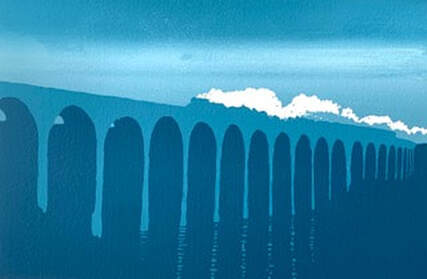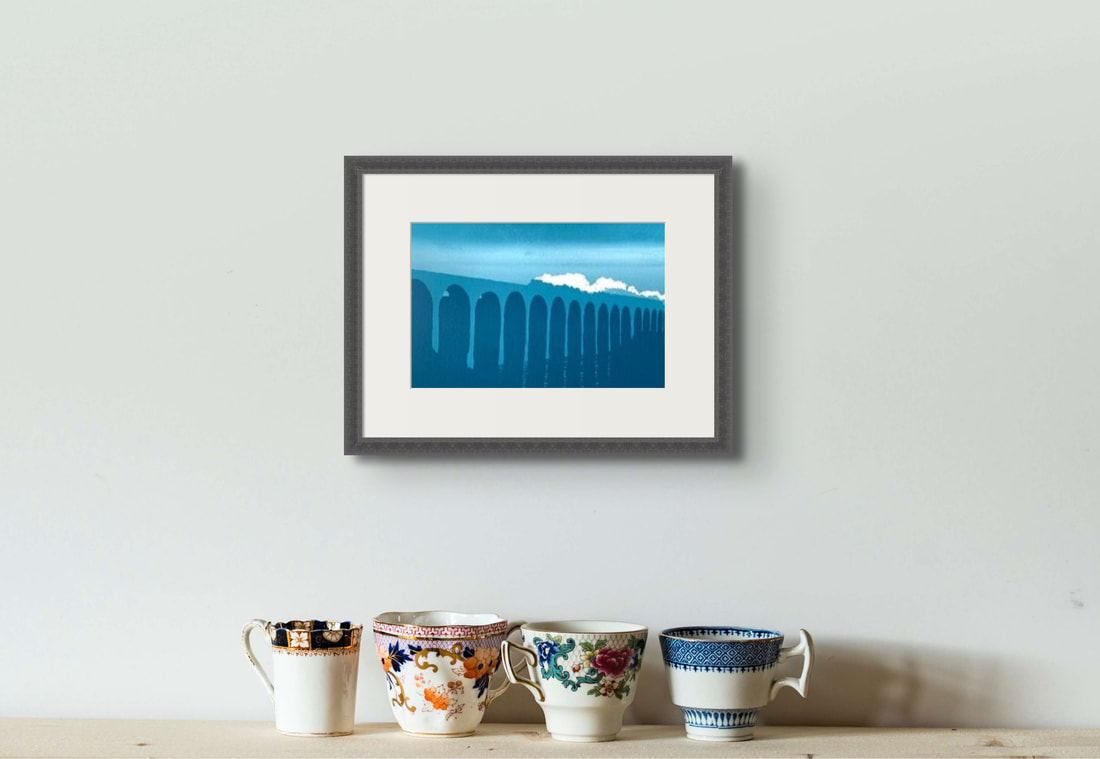The Border Bridge, Berwick by Ian Scott Massie
Reduction Screen Print - Edition of 13
16" x 12" Mounted size - 11" x 7" Image size
Available: unframed @ £130
To shop, please click here
16" x 12" Mounted size - 11" x 7" Image size
Available: unframed @ £130
To shop, please click here
THE BRIDGES OF BERWICK
The last great bridge on the East Coast Main Line, before the Scottish border, is the Royal Border Bridge over the River Tweed, one of George “Railway King” Hudson’s many projects.
As the glittering Tweed sits between high ground to the south and the north, a viaduct was needed to connect the two. Hudson’s engineer, Robert Stephenson, designed an elegant, gently curving bridge of 28 arches, thirteen of which stand in the river. For all its slender beauty, this is an enormous structure: the height of the tallest pier is 38.4m and the arches have spans of 18.6m. The viaduct stretches for a mile, including the approach embankments, and appears on many travel posters, particularly those from the 1930s.
My favourite view of Berwick is from the seaweedy cobbles next to the 17th century Berwick Bridge. From here the town of Berwick-On-Tweed rises on the opposite bank, with its lovely town hall, famously painted by L S Lowry. (He came here on holidays for about forty years). The bridge itself rises as it crosses the Tweed, its arches getting gradually higher. From this viewpoint, the Royal Border Bridge is visible through the graceful supports of the Royal Tweed Road Bridge. The Royal Tweed Bridge was built in the 1930s to divert traffic from the old bridge. It’s made from reinforced concrete - not a well-loved material in Britain - but the four curving arches are very harmonious. When built, it broke the record for the longest concrete span in Britain,
The town of Berwick-on-Tweed is a gem. It has an austere beauty, an unmatched ring of Tudor defensive walls and, not surprisingly, the air of an independent enclave. It is a town to which history has been spectacularly unkind. Edward 1 slaughtered 20,000 of the inhabitants - just one of many traumatic episodes. Its days of being a political football are thankfully over. It is simply unique - a town with a long history which feels neither English nor Scots.
As the glittering Tweed sits between high ground to the south and the north, a viaduct was needed to connect the two. Hudson’s engineer, Robert Stephenson, designed an elegant, gently curving bridge of 28 arches, thirteen of which stand in the river. For all its slender beauty, this is an enormous structure: the height of the tallest pier is 38.4m and the arches have spans of 18.6m. The viaduct stretches for a mile, including the approach embankments, and appears on many travel posters, particularly those from the 1930s.
My favourite view of Berwick is from the seaweedy cobbles next to the 17th century Berwick Bridge. From here the town of Berwick-On-Tweed rises on the opposite bank, with its lovely town hall, famously painted by L S Lowry. (He came here on holidays for about forty years). The bridge itself rises as it crosses the Tweed, its arches getting gradually higher. From this viewpoint, the Royal Border Bridge is visible through the graceful supports of the Royal Tweed Road Bridge. The Royal Tweed Bridge was built in the 1930s to divert traffic from the old bridge. It’s made from reinforced concrete - not a well-loved material in Britain - but the four curving arches are very harmonious. When built, it broke the record for the longest concrete span in Britain,
The town of Berwick-on-Tweed is a gem. It has an austere beauty, an unmatched ring of Tudor defensive walls and, not surprisingly, the air of an independent enclave. It is a town to which history has been spectacularly unkind. Edward 1 slaughtered 20,000 of the inhabitants - just one of many traumatic episodes. Its days of being a political football are thankfully over. It is simply unique - a town with a long history which feels neither English nor Scots.





